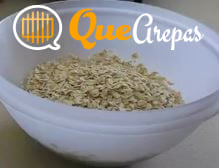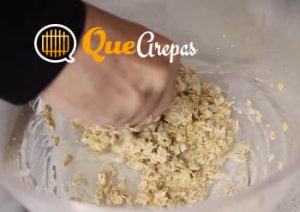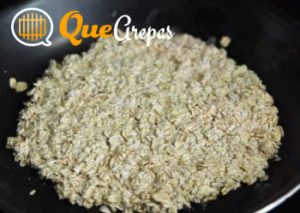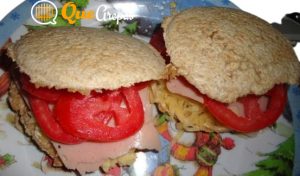Discover the new healthy and delicious way to enjoy arepas: arepas de avena!
Looking for a healthy and delicious breakfast option? Then arepas de avena are the answer! These arepas are a perfect combination of flavor and nutrition, made with simple, natural ingredients like oats and water. Plus, they are easy to make and can be customized with your favorite toppings for a personalized breakfast every morning. Try this recipe and feel the difference in your day!
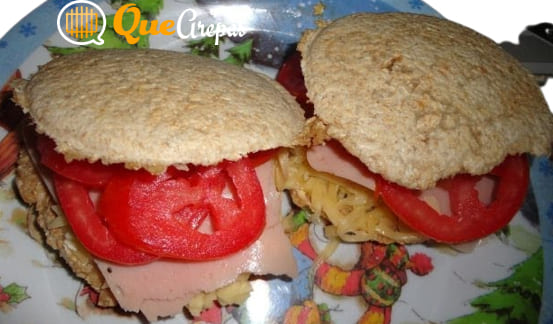
Aperitivos Venezolanos, Bollos Pelones, Tequeños, Patacones, Asado Negro
Do you like healthy recipes, but with a rich flavor? This is a recipe for my favorite arepa, Arepas de Avena, you can learn how to make one by following the simple instructions in the post.
An arepa is a kind of circular, flattened bread made from corn flour, and there are many different ways to make them. They can be plain or filled with ingredients such as cheese, beans, eggs, ham or any other filling you can imagine.
It gives you a Arepa Reina Pepiada?
- What is an arepa de avena?
- Why make arepas de avena?
- How are oatmeal arepas made?
- Arepas de Avena recipe - quearepas.com
- Recommendations when making arepas de avena
- Benefits of arepas de avena
- Why oatmeal arepas?
- Healthy Options for Filling Arepas de Avena
- Arepas de Avena: An Option for Everyone
- Frequently Asked Questions
What is an arepa de avena?
Arepas de Avena are made with ground oats that are mixed with water and cooked until a dough is formed. Corn flour can be added to give it consistency. From here, you can add any number of ingredients to make an oatmeal arepa or filling.
Oatmeal arepas are a Venezuelan staple, and are the perfect way to start the day.
Arepas are delicious and are often considered nutritious because they are made from whole grains that have been soaked in water before being baked into dough. These little empanadas are very popular in Venezuela as a snack or meal during the day.
It gives you a Arepa con Queso?
Why make arepas de avena?
Oatmeal arepas are a healthier version of the arepa than cornmeal arepas. It's made with oat flour instead of cornmeal, which makes them gluten-free and much healthier than traditional arepas. They can be made ahead of time and frozen, so you can make a big batch ahead of time for breakfast, lunch or dinner on the go.
The main advantage of oatmeal arepas is their versatility: you can add almost anything you want to them! Some common ingredients are: cinnamon, peanut butter, honey, chocolate chips (if you're feeling adventurous) or even fresh fruit (like bananas).
How are oatmeal arepas made?
This is simple, the only variation you have to make compared to corn flour arepas, is to substitute all or part of it with oatmeal. Then the process is the same as for traditional arepas. Below you have the step by step recipe with all the details.

Arepas de Avena recipe - quearepas.com
Ingredients
- 2 tazas water at room temperature, not cold.
- 1/2 cucharadita salt
- 2 tazas oat flakes
Instructions
- Place the water and salt in a large bowl and stir to combine.
- Add the oats and stir until the mixture is completely combined, about 3 minutes. Wet your hands with to prevent the dough from sticking.
- Scoop out a scant 1/4 cup of the dough, then form it into a ball between the palms of your hands and flatten it slightly into a patty about 2 inches wide (don't make it too thin or it will cook before it gets crispy). Repeat with the rest of the dough.
- Heat the nonstick skillet over medium heat and add the arepas, working in batches if necessary. Cook without touching them until the underside begins to brown, 6 to 7 minutes. Turn the arepas over and cook until well browned on both sides, another 5 to 6 minutes more; adjust the heat as needed to prevent burning. Remove from the pan to cool completely on a wire rack while repeating the operation with the remaining arepas.
- Serve immediately or store refrigerated for up to 7 days or frozen for up to 3 months (thaw in the microwave for 30 seconds).
Video
Notes
Nutritional information of an oatmeal arepa
Oatmeal cornmeal arepas have a variety of important nutrients. Generally speaking, a 2.5-ounce (71-gram) arepa can have the following:- Calories: about 150-200 calories
- Proteins: 3-4 grams
- Fat: 4-6 grams
- Carbohydrates: 25-30 grams
- Fiber: 2-3 grams
- Sodium: about 150 mg
Recommendations when making arepas de avena
- Use flaked oats: To make oatmeal arepas, it is advisable to use flaked oats instead of instant oatmeal, as the texture and consistency will be better.
- Use hot water: When mixing the oats with the water and salt, use hot water so that the oats hydrate better and the dough will be smoother.
- Let the dough rest: After mixing the ingredients, let the dough rest for a few minutes so that the oats are fully hydrated and the dough is easier to handle.
- Add wheat or corn flour if necessary: If the dough is too liquid or sticky, you can add a little wheat or corn flour to give it consistency.
- Form the arepas with wet hands: To form the oatmeal arepas, it is advisable to have wet hands to prevent the dough from sticking and to give it a uniform shape.
- Cook over medium heat: Cook the oatmeal arepas over medium heat so that they cook evenly and do not burn.
- Serve hot: Oatmeal arepas are softer and fluffier when served hot, so it is advisable to serve them immediately after cooking.
Benefits of arepas de avena
What if you're looking for a vegan option? Arepas de avena are perfect for you. Just swap the milk for almond or soy milk and voila, you've got yourself a vegan breakfast.
Oatmeal is rich in fiber, so it helps maintain satiety longer than other breakfast foods. It also stimulates metabolism by providing slow-burning energy throughout the day.
Oatmeal arepas contain several nutrients that make them a healthy addition to any diet. Among them are:
- Avena - Oats contain beta glucan which has been shown to reduce cholesterol levels by up to 10% over time. It also contains soluble fiber that helps keep the digestive system regular and healthy.
- Hierro - Oatmeal contains iron which helps maintain your body's hemoglobin levels so it can carry oxygen through your bloodstream to your muscles and organs more efficiently than if you had no iron at all. This means that your muscles will feel less tired during exercise sessions because they are getting enough oxygen from your bloodstream without the need to
Arepas de Avena are a good source of protein and fiber: one serving contains about 5 grams of protein and 3 grams of fiber. They also contain vitamin B6, which is important for overall immune function. Oat arepas have been shown to reduce cholesterol levels by 15% over six months compared to wheat-based diets.
Oatmeal arepa is a delicious and healthy breakfast that can be prepared in just a few minutes. It is made with rolled oats, which are ground and cooked in boiling water until soft. This mixture is spread on a corn cake - which looks similar to an English muffin - and topped with fruit and honey, cinnamon and nutmeg, or whatever you like!
Arepas de avena are a type of flatbread made with ground oats and water. They are popular throughout South America, especially in Colombia and Venezuela. In Colombia, they are usually eaten as breakfast with toppings such as cheese or roast pork. In Venezuela, on the other hand, arepas de avena arepas are usually eaten as an accompaniment to stews or soups.
Why oatmeal arepas?
Arepas de avena are a staple food in Venezuela. They are small patties made of ground oatmeal and cheese, which are then grilled for breakfast or dinner. Easy to make, cheap, delicious and healthy. The oatmeal arepas have become my new favorite breakfast which makes me so happy because:
- I don't have to spend a lot of money on fancy cereals.
- It's so healthy for me
- It's yummy. I eat it during the week and also on weekends at brunch.
Which Arepas do you prefer Venezuelan Arepas or Colombian Arepas?
Healthy Options for Filling Arepas de Avena
If you're looking for healthy, low-calorie options for filling your oatmeal arepas, you're in the right place. Here are some creative ideas that are not only nutritious, but also full of fresh and colorful ingredients that provide additional health benefits.
- Chicken and Avocado Salad:
- Filling: Grilled chicken breast cut into small pieces, sliced avocado, diced tomato, lettuce and a touch of lemon.
- This option is rich in protein and healthy fats. The avocado adds a creamy texture while the chicken and lettuce provide satiety and freshness.
- Healthy Caprese:
- Filling: Tomato slices, fresh sliced mozzarella, basil leaves and a drizzle of olive oil.
- This classic Italian combination is low in calories and rich in antioxidants. The tomato provides lycopene, the mozzarella offers protein and the heart-healthy olive oil complements the flavor.
- Hummus and Vegetables:
- Filling: Homemade or store-bought hummus, cucumber slices, bell bell pepper strips and grated carrot.
- Hummus is an excellent source of vegetable protein and fiber. When combined with crunchy vegetables, you get a nice texture and an extra dose of nutrients.
- Tuna and Vegetable Salad:
- Filling: Canned tuna in water, drained, mixed with grated carrot, chopped celery, thinly sliced red onion and low-fat Greek yogurt.
- This option is low in calories and rich in protein. The tuna provides omega-3 fatty acids, while the vegetables add essential vitamins and minerals.
- Quinoa and Avocado Salad:
- Filling: Cooked quinoa, diced avocado, diced tomato, diced cucumber and chopped cilantro.
- Quinoa is an excellent source of protein and fiber, and combined with avocado and fresh vegetables, this salad brings a variety of nutrients and textures to your oatmeal arepas.
- Sautéed Spinach with Feta Cheese:
- Filling: Fresh spinach sautéed with garlic and olive oil, crumbled feta cheese and halved cherry tomatoes.
- The spinach is rich in iron and antioxidants, while the feta cheese adds a salty, creamy flavor. This combination is a delicious and healthy option.
Arepas de Avena: An Option for Everyone
Oatmeal arepas are a versatile and delicious alternative that can be adapted to different dietary preferences and dietary needs. Below, I'll show you how to make oatmeal arepas suitable for vegan and vegetarian diets, as well as how to adapt them for people with food intolerances.
- Vegan Arepas de Avena:
- Replace cow's milk with vegetable milk, such as almond milk, coconut milk or oat milk. This will allow you to obtain an arepa dough without animal ingredients.
- Use vegetable oil instead of butter to grease the pan when cooking the arepas.
- Be sure to select vegan fillings, such as veggies, legumes, vegan sauces and vegan cheeses, to complement your oatmeal arepas.
- Vegetarian Arepas de Avena:
- If you consume dairy, you can use cow's milk in the preparation of the arepa dough.
- Opt for fillings that include dairy products, such as cheeses and yogurts, to add a touch of creaminess and flavor to your oatmeal arepas.
- Gluten Free Arepas de Avena:
- Be sure to use certified gluten-free oats to avoid any possible cross-contamination.
- Instead of using wheat flour to seal the arepas, you can opt for gluten-free flours, such as precooked corn flour or rice flour.
- Lactose-Free Arepas de Avena:
- Use lactose-free milk or vegetable milk in the preparation of the arepa dough.
- Opt for fillings that do not include dairy, such as vegetables, vegetable proteins, dairy-free sauces and lactose-free cheeses.
- Arepas de Avena without eggs:
- Instead of using eggs to bind the arepa dough, you can add a little more liquid (milk or water) and oil to the mixture until you obtain a suitable consistency.
- When cooking the arepas, be sure to use enough oil on the cooking surface to prevent them from sticking.
Do you want to enjoy a good Arepa?
Frequently Asked Questions
What is an oat arepa?
An arepa de avena is a variation of the classic Venezuelan arepa in which oat flour is used instead of corn flour. The oat flour gives the arepas a softer texture and a slightly sweet flavor.
How are oatmeal arepas made?
To make oatmeal arepas, oat flour is mixed with water and salt until a soft and manageable dough is obtained. Then, form discs with the dough and cook them in a frying pan or griddle until they are golden brown on the outside and cooked on the inside.
What is the difference between oat arepas and corn flour arepas?
The main difference lies in the ingredients used. While corn flour arepas are made with pre-cooked corn flour, oat arepas use oat flour. This results in a different texture and flavor, with oatmeal arepas being softer and with a sweet touch.
If you want to know other articles similar to Discover the new healthy and delicious way to enjoy arepas: arepas de avena! you can visit the category Fitness.

